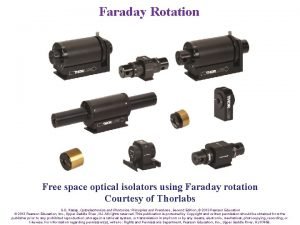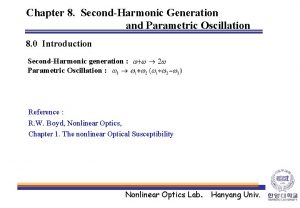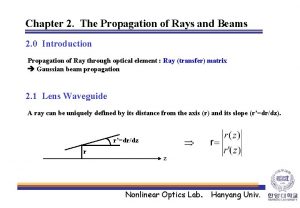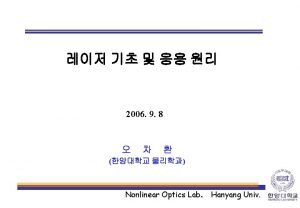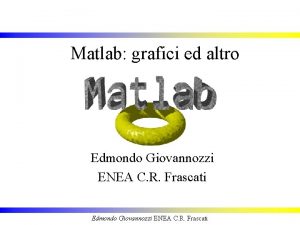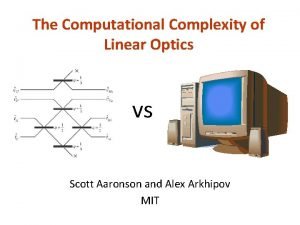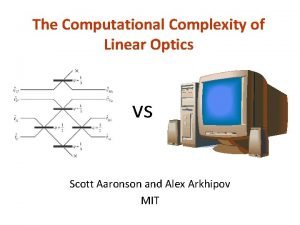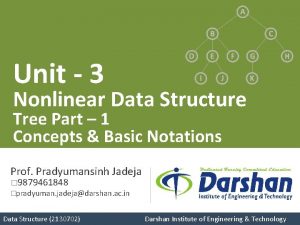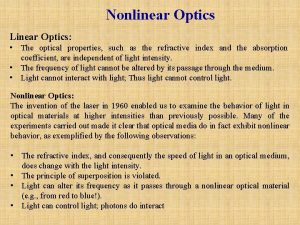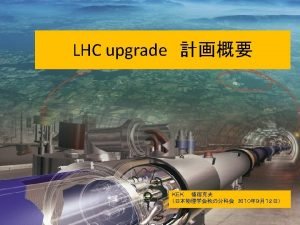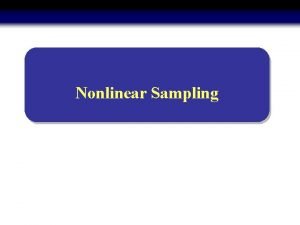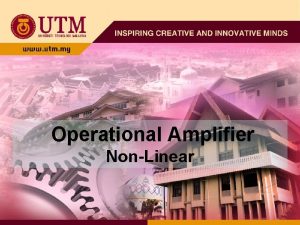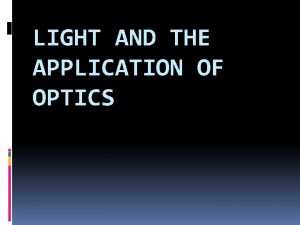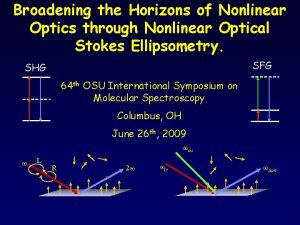LHC Optics MDs linear and nonlinear M Giovannozzi












- Slides: 12

LHC Optics MDs: linear and nonlinear M. Giovannozzi on behalf of HSS team Acknowledgements: G. Arduini, L. Malina, E. Métral, Y. Papaphilippou, T. Persson, T. Pieloni, P. Skowronski. 18/01/2016 LHC Studies WG - MG 1

Introduction - I • The proposed studies cover different needs – Understanding the present -> 2016 run – Preparing the medium term -> Run 2 – Building the long term -> HL-LHC • The boundary between the various domains (linear, non-linear optics/collimation/beam…) is not always sharp. – Some of the studies presented under “linear, nonlinear optics” will require, e. g. , • aperture evaluation • Analysis of beam-beam effects – To draw firm conclusions from the results. 18/01/2016 LHC Studies WG - MG 2

Introduction - II • Based on the experience from the 2015 MD sessions: – The use of the alignment optics proved essential to provide robust calibration of the IR BPMs, which in turns is an essential ingredient for beta* measurement and correction (hence, directly linked with machine performance). – It is assumed that the alignment optics will be used during the 2016 beam commissioning period. Otherwise, a request to pursue the studies started in 2015 with the alignment optics will be issued. 18/01/2016 LHC Studies WG - MG 3

Introduction - III • MD studies vs. operational development: – The distinction is not always clear… – There are plans to put in operation a very high beta* optics in 2016 • The commissioning should start well ahead of the planned operational period, due to the intrinsic difficulties of this optics. • Enough time should be allocated to study this optics (no matter whether this is taken from the MD budget or from physics time). 18/01/2016 LHC Studies WG - MG 4

Linear optics - I • Pursue studies of linear coupling measurement and correction – The use of the DOROS system enabled accurate measurement of linear coupling in 2015 MD blocks. – This could be extended through the ramp and squeeze with the ultimate goal of providing automatic corrections of the coupling. • Study different optical configurations at injection energy, e. g. , with lower beta* – These studies aim at probing different conditions at injection to verify optics correctability, aperture, and impact of field quality on beam dynamics, e. g. , to mimic top energy configurations – To note that lower beta* at injection might have a mild impact on performance by relaxing conditions for ramp and squeeze. 18/01/2016 LHC Studies WG - MG 5

Linear optics - II • Study future optical configurations for collisions, such as pushed round optics (minimum beta* to be defined) or flat optics – This study will aim at characterising special optics configurations, possibly for future LHC runs. – Several aspects will be probed in addition to linear optics measurement and control, namely: aperture and beam-beam effects. • Pursue the study of half integer tunes in the LHC – This study was initiated back in 2011 with some initial observations. The study should be resumed as this might be an option for LHC and future colliders. Includes beam-beam studies. 18/01/2016 LHC Studies WG - MG 6

Non-linear optics - I • Three main themes are addressed by MD studies – Understanding the non-linear model of the LHC (injection and top energy). – Devise correction strategies for the existing correction circuits, such as spool pieces and corrector package in the triplets (injection and top energy). – Study global observables sensible to non-linear effects and providing indications on machine performance (injection and top energy). Immediate application is the definition of complementary approaches to set the elements of the corrector package. 18/01/2016 LHC Studies WG - MG 7

Non-linear optics - II • Injection – Measurement of natural chromaticity – b 3, b 4, b 5 • Checks locality of corrections using long bumps in the arcs. • Understand contribution of MCDOs on Q’’ and Q’’’. • Verify presence of systematic misalignment of spool pieces. – Non-linear coupling • Direct measurement of linear coupling at different amplitudes in the presence of octupolar effects (reverse measurement, detuning vs tune difference, could be tried too). • Top energy – Measurement of nonlinear chromaticity and detuning with amplitude 18/01/2016 LHC Studies WG - MG 8

Non-linear optics - III • Top energy – Non-linear errors in experimental insertions • Correction of understood errors: To be done in commissioning – Studies of the non-linear errors in the IRs for several optical configurations (to disentangle in a better way the various contributions) • • Beta* of 40 cm Pushed round optics Flat optics One IR at a time 18/01/2016 LHC Studies WG - MG 9

Non-linear optics - IV • Dynamic aperture studies – Injection Decreasing priority • Probe dependence of DA on b 6 corrector strength to find an alternative/complementary way to set it (other than considering feed down effects). • Direct comparison of experimental methods to probe dynamic aperture (kick method and intensity evolution method). • Direct measurement of short term dynamic aperture with AC dipole. • Direct measurement in several configurations, e. g. , strong octupoles, off-momentum, in view of benchmarking numerical simulations. – Top energy (squeezed optics) • Direct measurement using the proposed relationship between DA and intensity evolution. • Direct measurement of short term dynamic aperture with AC dipole. 18/01/2016 LHC Studies WG - MG 10

Another topic: background studies • Background is a potential issue and a better understanding is essential not only for LHC, but also for future machines. These proposals follow LBS discussions: – Background vs controlled pressure rise – Search for background from synchrotron radiation 18/01/2016 LHC Studies WG - MG 11

Proposal of prioritisation of MD studies • High priority – – Coupling measurement Pushed optics (flat or round) IR non-linearity studies DA studies at injection • Medium – – – Non-linear errors at injection Different optical configurations at injection DA studies at top energy Half integer tunes Background studies 18/01/2016 LHC Studies WG - MG 12
 Difference between ray optics and wave optics
Difference between ray optics and wave optics Venn diagram of geometric optics and physical optics
Venn diagram of geometric optics and physical optics Nonlinear optics
Nonlinear optics Nonlinear optics
Nonlinear optics Nonlinear optics
Nonlinear optics Nonlinear optics
Nonlinear optics Sovrapporre grafici matlab
Sovrapporre grafici matlab The computational complexity of linear optics
The computational complexity of linear optics The computational complexity of linear optics
The computational complexity of linear optics Linear and nonlinear data structure
Linear and nonlinear data structure Linear editing vs non linear editing
Linear editing vs non linear editing Linear and nonlinear data structure
Linear and nonlinear data structure Non linear text
Non linear text


